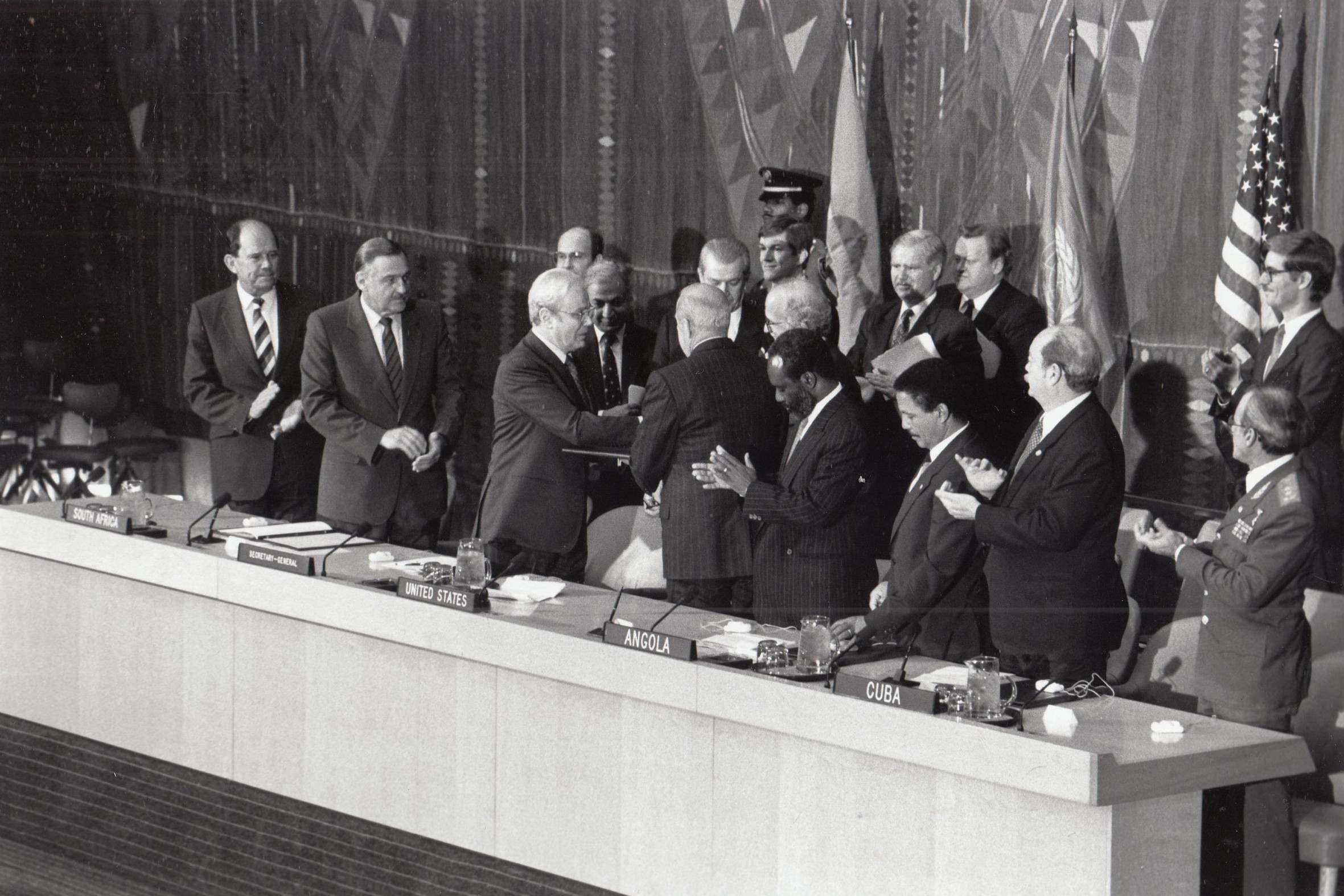Namibia’s journey to independence was marked by decades of struggle, international diplomacy, and the changing dynamics of the Cold War. Central to the final resolution of Namibia’s colonial status was the Tripartite Accord, a historic agreement that paved the way for the country’s eventual independence from South Africa in 1990. This accord represented a turning point, not only for Namibia but also for southern Africa, as it marked the end of apartheid rule and the beginning of a new era of self-determination. This article provides an in-depth look at the Tripartite Accord, examining its background, key provisions, and its impact on Namibia’s path to independence.
The Context: Namibia’s Struggle for Independence
Namibia, formerly known as South West Africa, had been under colonial control for over a century. Initially a German colony, it became a League of Nations mandate under South Africa’s administration after World War I. South Africa’s apartheid policies were extended to Namibia, where the indigenous Namibian people were subjected to racial segregation, land dispossession, and political disenfranchisement.
The South West Africa People’s Organization (SWAPO), founded in 1960, became the primary liberation movement in the country, advocating for the end of South African rule and the establishment of an independent Namibia. SWAPO’s military wing, the People’s Liberation Army of Namibia (PLAN), waged a protracted guerrilla war against South African forces. However, despite the movement’s growing influence, Namibia remained under South African occupation.
Internationally, the situation was a matter of great concern, particularly within the United Nations (UN). The UN had repeatedly called for South Africa to relinquish control over Namibia and allow for the establishment of a democratic government. However, South Africa, supported by Western powers like the United States, resisted these calls, fearing the potential rise of socialist governments in southern Africa.
The Role of the Cold War and Regional Dynamics
The Tripartite Accord did not emerge in a vacuum. It was deeply influenced by the broader geopolitics of the Cold War and the shifting balance of power in southern Africa. By the 1980s, the region was a focal point of ideological conflict between the Western bloc, led by the United States, and the socialist bloc, led by the Soviet Union. South Africa, a key ally of the United States, had long supported anti-communist forces in Angola and Mozambique, while SWAPO had received backing from the Soviet Union, Cuba, and other socialist nations.
The Cold War conflict played out on multiple fronts in southern Africa. In Angola, the civil war between the socialist MPLA (Popular Movement for the Liberation of Angola) and the U.S.-backed UNITA (National Union for the Total Independence of Angola) was exacerbated by South Africa’s military involvement. South Africa’s intervention in Angola in the mid-1970s and its subsequent military operations in the region led to a protracted conflict with Cuban forces, who were supporting the MPLA. The growing stalemate in Angola, combined with increasing international pressure on South Africa, led to a recognition that a resolution to Namibia’s political status was essential for regional stability.
The Tripartite Accord: Key Provisions and Stakeholders
The Tripartite Accord, officially known as the “New York Agreement”, was signed on December 22, 1988, between three primary parties: the Republic of South Africa, the People’s Republic of Angola, and the Cuban Government. It was also supported by the United Nations, which played a pivotal role in facilitating the agreement. The accord was a product of intense diplomacy, particularly spearheaded by the United States and the Soviet Union, both of whom sought to ease tensions in the region while securing their respective ideological interests.
Key Provisions of the Tripartite Accord
- Withdrawal of Cuban Troops from Angola: One of the key aspects of the agreement was the commitment by Cuba to withdraw its military forces from Angola. Cuban troops had been instrumental in supporting the MPLA government in Angola’s civil war, and their presence was a source of friction between the United States and the Soviet Union. The Tripartite Accord called for a phased withdrawal of Cuban troops, which was a crucial step in facilitating peace in Angola and easing regional tensions.
- End of South African Occupation in Namibia: In return for the Cuban troop withdrawal, South Africa agreed to the withdrawal of its military forces from Namibia and to allow the implementation of United Nations Security Council Resolution 435 (UNSCR 435). UNSCR 435 had been adopted in 1978 as a blueprint for a transition to Namibian independence. The resolution outlined a process for free and fair elections and the establishment of a new government. South Africa’s commitment to withdraw its forces and allow for UN-supervised elections was a critical step in moving Namibia towards self-rule.
- UN Supervision of Elections: The Tripartite Accord set the framework for the United Nations to oversee the implementation of the transition process, including the monitoring of elections. A UN Transition Assistance Group (UNTAG) was established to supervise the electoral process and ensure that the elections were free and fair. SWAPO, as the leading liberation movement, was recognized as the legitimate representative of the Namibian people, but other political parties were also allowed to participate in the election.
- Transition to Independence: The agreement set a timetable for Namibia’s transition to independence. The implementation of UNSCR 435, the withdrawal of South African troops, and the supervision of elections by the UN paved the way for Namibia’s independence. Following the election, Namibia was to gain full sovereignty, with SWAPO’s Sam Nujoma being a leading candidate for the presidency.
The Significance of the Accord
The Tripartite Accord was a diplomatic breakthrough, marking the end of a long, bitter conflict in southern Africa. The agreement was significant for several reasons:
- A Step Toward Regional Peace: The agreement played a key role in stabilizing southern Africa. By facilitating the withdrawal of Cuban troops from Angola and ending South Africa’s military presence in Namibia, the accord helped reduce Cold War tensions in the region. It also laid the groundwork for a future peace process in Angola, leading to the eventual conclusion of the Angolan Civil War in 2002.
- A Diplomatic Victory for the United Nations: The Tripartite Accord demonstrated the United Nations’ ability to broker a peaceful resolution to a complex and long-standing conflict. The UN’s involvement in overseeing the elections in Namibia provided a model for future peacekeeping and transition efforts in other post-colonial settings.
- A Triumph for Namibia’s Independence Movement: For the people of Namibia, the Tripartite Accord represented the beginning of the end of South Africa’s oppressive rule. The accord marked a turning point in the struggle for independence, setting in motion a process that would culminate in Namibia’s first democratic elections in 1989 and its formal independence in 1990.
- International Solidarity and Cooperation: The success of the Tripartite Accord was the result of broad international cooperation. The involvement of multiple stakeholders, including the United States, the Soviet Union, and the United Nations, highlighted the power of diplomacy and negotiation in resolving conflicts. The accord also showcased the power of solidarity among the countries of the Global South, particularly the role of Angola, Cuba, and SWAPO in supporting Namibia’s struggle for independence.
Namibia’s Independence: The Aftermath of the Accord
The successful implementation of the Tripartite Accord culminated in Namibia’s first free and fair elections in November 1989, where SWAPO emerged as the dominant political force. On March 21, 1990, Namibia officially gained independence, with Sam Nujoma becoming the country’s first president. The peaceful transition to independence was a remarkable achievement, made possible in large part by the diplomatic efforts encapsulated in the Tripartite Accord.
The Tripartite Accord was a pivotal moment in Namibia’s journey to independence. It brought together diverse stakeholders, including Cuba, Angola, South Africa, and the United Nations, to chart a path toward peace and self-determination. The agreement not only facilitated Namibia’s independence but also contributed to the broader goal of peace and stability in southern Africa. It is a testament to the power of diplomacy and international cooperation in resolving even the most intractable conflicts. Today, Namibia stands as a beacon of peace and progress, a legacy shaped in part by the Tripartite Accord.
Join 'Namibia Today' WhatsApp Channel
Get the breaking news in Namibia — direct to your WhatsApp.
CLICK HERE TO JOIN












